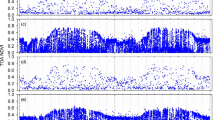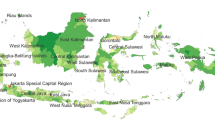Abstract
Vegetation monitoring is an important step in developing a better understanding of land use and its changes, due to the sensitivity of surface vegetation to changes in the global climate and environment. In this study, normalized difference vegetation index (NDVI) of the area surrounding the Gobi Desert in North Asia was multi-temporally interpreted by analyzing time-series Satellite Pour l’Observation de la Terre (SPOT) Vegetation (VGT) data, over a roughly nine-year period from January 1999 to November 2007. The study area was classified into eight classes, and compared to classified Moderate resolution Imaging Spectrometer (MODIS) global land-cover data to select desertification-sensitive areas. The study focused on three classes (barren land, open shrubland, grassland) due to their high sensitivity to climate change. The results showed significant extension of the barren land class from 1992 to 1999, with 47.8% of the open shrubland transformed into barren land. Among five terms (1999–2003, 2003–2005, 2005–2007, 1999–2005, 1999–2007) which are carefully selected from variations of the annual NDVI mean for each class over nine years, significant changes were observed for barren land from 1999–2003, and for open shrubland and grassland from 2005–2007. An analysis of the positive change (the change from sparse vegetation to dense vegetation) and negative change (or desertification) was conducted over the study period; the number of pixels corresponding to a positive change for barren land was similar to the number of negative change pixels. Human activity and afforestation over the study area were also captured in multitemporal satellite imagery. For open shrubland and grassland, the negative change area was bigger than the positive change area. Precipitation data over the nine-year period exhibited a pattern similar to that for the vegetation data, as expected.
Similar content being viewed by others
References
Bethany, A. B., W. J. Robert, F. H. John, and F. M. John, 2006: A curve fitting procedure to derive inter-annual phenologies from time series of noisy satellite NDVI data. Remote Sens. Environ., 83, 137–145.
Bartholomé, E., P. Bogaert, M. Cherlet, P. Defourny, P. Mathoux, and P. Vogt, 2002: Rescaling NDVI from the VEGETATION instrument into apparent fraction cover for dryland studies. GLCC-2000. First Results Workshop. JRC-ISPRS.
Chase, T. N., R. A. Pielke, J. Knaff, T. Kittel, and J. Eastman, 2000: A comparison of regional trends in 1979–1997 depth-averaged tropospheric temperatures. Int. J. Climatol., 20, 503–518.
Yu F., K. P. Price, J. Ellis, and P. Shi, 2003: Response of seasonal vegetation development to climatic variations in eastern central Asia. Remote Sens. Environ., 87, 42–54.
Feng, H. H., X. F. Zhao, F. Chen, and L. C. Wu, 2014: Using land use change trajectories to quantify the effects of urbanization on urban heat island. Adv. Space Res., 53, 463–473.
FAO, 2010: Global Forest Resources Assessment 2010, main report, Food and Agriculture Organization of the United Nations, Rome, 340.
Friedl, M. A., D. K. McIver, J. C. F. Hodges, X. Y. Zhang, D. Muchoney, and A. H. Strahler, 2002: Global land cover mapping from MODIS: algorithms and early results. Remote Sens. Environ., 83, 287–302.
Fu, C., 1994: An aridity trend in China in association with global warming. In: R.G. Zepp (ed.) Climate-Biosphere Interaction: Biogenic Emissions and Environmental Effects of Climate Change. JohnWiley and Sons, Inc. 1–18.
—, and F. Wei, 1993: Study on sensitivity of meso-scale model in response to land cover classification over China. EOS, Transactions, American Geophysical Union, 172.
Hansen, M. C., and B. Reed, 2000: A comparison of the IGBP DISCover and University of Maryland 1 km global land cover products. Int. J. Remote Sens., 21, 1365–1373.
Holben, B. N., 1986: Characteristics of maximum-value composite images from temporal AVHRR data. Int. J. Remote Sens., 7, 1417–1434.
Kim, H. O., and J. M. Yeom, 2012: Multi-temporal spectral analysis of rice fields in South Korea using MODIS and RapidEye satellite imagery. J. Astron. Space Sci., 29, 407–411.
Lee, R., F. Yu, K. P. Price, J. Ellis, and P. Shi, 2002: Evaluating vegetation phenological patterns in Inner Mongolia using NDVI time-series analysis. Int. J. Remote Sens., 23, 2505–2512.
Liu, J. Y., D. F. Zhuang, D. Luo, and X. Xiao, 2003: Land-cover classification of China: integrated analysis of AVHRR imagery and geophysical data. Int. J Remote Sens., 25, 2365–2407.
Lu, D., P. Mausel, E. Brondizio, and E. Moran, 2003: Change detection techniques. Int. J. Remote Sens., 24, 2485–2500.
Maselli, F., 2004: Monitoring forest conditions in a protected Mediterranean coastal area by the analysis of multi year NDVI data. Remote Sens. Environ., 89, 423–433.
Merriam Webster, 2003: Merriam-Webster’s collegiate dictionary, 11th Edition, Merriam-Webster, Inc. 1664.
Mingguo, M., and F. Veroustraete, 2006: Interannual variability of vegetation cover in the Chinese Heihe River Basin and its relation to meteorological. Int. J. Remote Sens., 27, 3473–3486.
Roujean, J. L., M. Leroy, and P. Y. Deschamps, 1992: A bidirectional reflectance model of the Earth’s surface for the correction of remote sensing data. J. Geophys. Res. 97, 20455–20468.
Sudipta, S., and M. Kafatos, 2004: Interannual variability of vegetation over the Indian sub-continent and its relation to the different meteorological parameters. Remote Sens. Environ., 90, 268–280.
Weiss, J. L., D. S. Gutzler, J. A. Coonrod, and C. N. Dahm, 2004: Longterm vegetation monitoring with NDVI in a diverse semi-arid setting, central New Mexico, USA. J. Arid Environ., 58, 248–271.
Yagoub, H., A. H. Belbachir, and N. Benabadji, 2014: Detection and mapping vegetation cover based on the spectral angle mapper algorithm using NOAA AVHRR data. Adv. Space Res., 53, 1686–1693.
Yeom, J. M., and K. S. Han, 2009: An efficiency analysis for data synthesis of Sun- and Geo- synchronous satellites in Kernel-driven BRDF model. Asia-Pac. J. Atmos. Sci., 45, 499–511.
Zhou, L., C. J. Tucker, R. K. Kaufmann, D. Slayback, N. V. Shabanov, and R.B. Myneni, 2001: Variations in northern vegetation activity inferred from satellite data of vegetation index during 1982 to 1999. J. Geophys. Res., 106, 20083.
Author information
Authors and Affiliations
Corresponding author
Rights and permissions
About this article
Cite this article
Han, KS., Park, YY. & Yeom, JM. Detection of change in vegetation in the surrounding Desert areas of Northwest China and Mongolia with multi-temporal satellite images. Asia-Pacific J Atmos Sci 51, 173–181 (2015). https://doi.org/10.1007/s13143-015-0068-3
Received:
Accepted:
Published:
Issue Date:
DOI: https://doi.org/10.1007/s13143-015-0068-3




